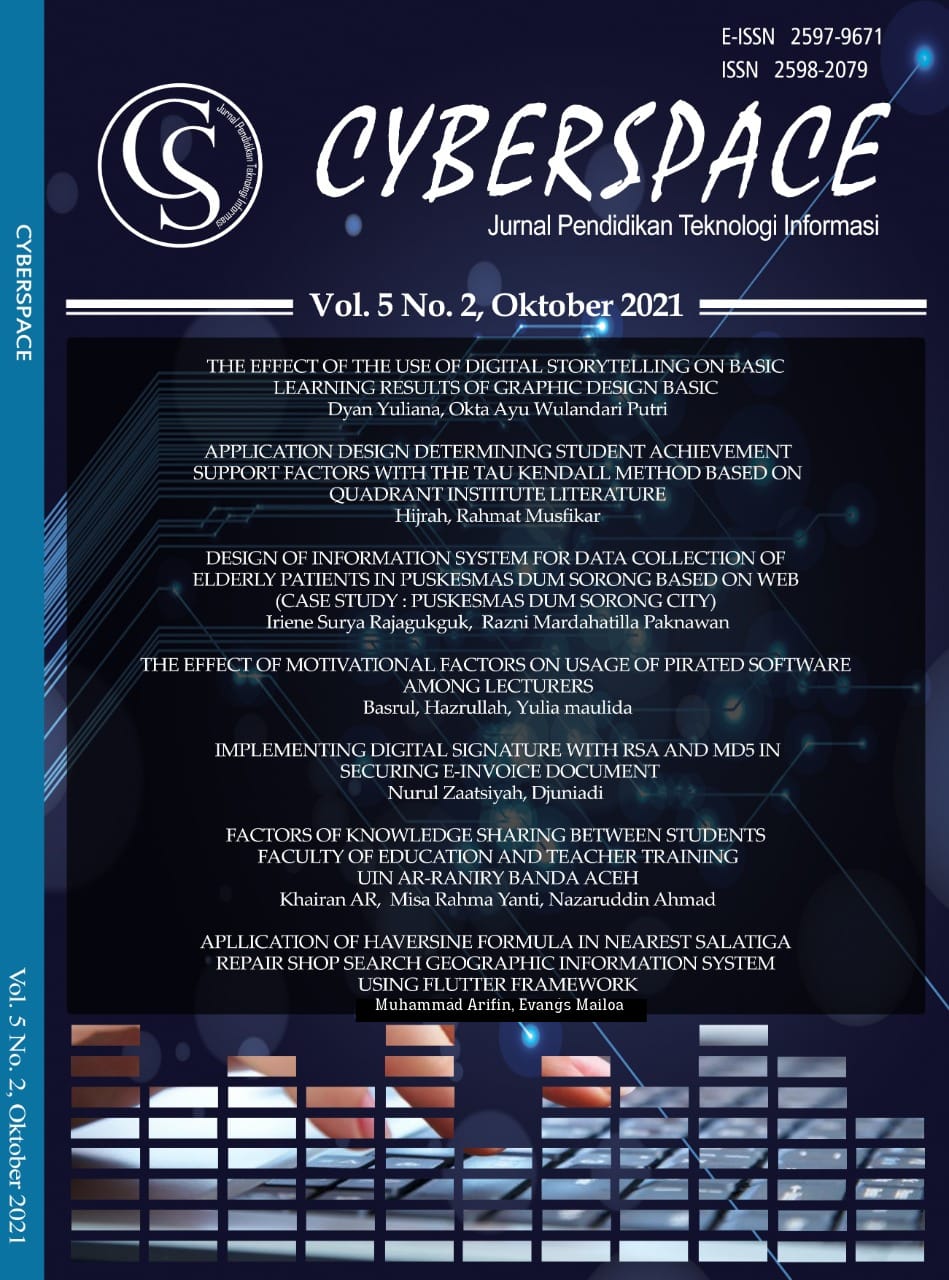THE EFFECT OF THE USE OF DIGITAL STORYTELLING ON BASIC LEARNING RESULTS OF GRAPHIC DESIGN BASIC
DOI:
https://doi.org/10.22373/cj.v5i2.9347Keywords:
Digital Storytelling learning, learning outcomesAbstract
The development of Information and Communication Technology today has grown very rapidly, this is evidenced by the emergence of sophisticated technological equipment that has changed the lifestyle of humans at this time. As a teacher, of course we must be able to adjust the way of educating them according to their way of life in the digital era. Teachers are required to carry out an innovation in the learning process in the classroom, to support the needs needed in implementing active learning in the classroom, there is a need for media that can support the implementation of learning optimally to spur effective communication skills through active learning that integrates information and communication technology. namely Digital Storytelling (digital storytelling) which is a strategy to use a computer application program that combines audio and visual media. This study used a quantitative research approach with the type of pre-experimental designs with the form of one group pretest posttest design. The decision making of hypothesis testing uses the help of the SPSS version 25 program. The hypothesis testing technique uses the paired sample t-test and simple linear regression. The results obtained through the paired sample t-test in SPSS version 25, namely the sig value. (2- tailed) of 0.001. In accordance with the basis of decision making in the paired sample T-test that the sig. (2-tailed) <0.05 or 0.001 <0.05, then H0 is rejected and Ha is accepted. This means that there is a significant difference between the pretest and posttest results. To find out what percentage of this influence is, it is necessary to look for the coefficient of determination (R Square) with a simple linear regression test in SPSS version 25 and it was found that the effect of Digital Storytelling on student learning outcomes is 0.142 or 14.2% which can be concluded that Digital Storytelling has an effect. which is very low on student learning outcomes at SMKN 1 Kendit.References
Nunu Mahnun, “Peranan Media Pembelajaran Dalam Meningkatkan Minat Belajar Mahasiswa,” J. Komun. Pendidik., vol. 2, no. 2, p. 103, 2012, doi: 10.32585/jkp.v2i2.113.
Yudiantara, “Pengembangan Media Pembelajaran Berbasis Multimedia Pada Mata Kuliah Kompetensi Pembelajaran Pokok Materi Keterampilan Dasar Mengajar,” J. Pendidik. Tek. Sipil, vol. 8, no. 1, pp. 24–30, 2015.
Frazel, “PENERAPAN DIGITAL STORYTELLING DALAM PEMBELAJARAN BAHASA metode pengajaran dengan memanfaatkan komputer dan internet . Salah satu metode yang,” no. September 2017, 2010.
Miller, “DIGITAL STORYTELLING UNTUK MENGEMBANGKAN ASPEK SPIRITUAL ANAK TAMAN KANAK-KANAK ( TK ) AL-HIDAYAH BAKUNG 01 KABUPATEN BLITAR,” no. september, 2011.
Nursalam, “Journal of Telenursing,” vol. 1, pp. 67–79, 2013.
Rosidatun, “STORYTELLING DENGAN MEDIA BUKU KOSAKATA,” no. September, pp. 20–21, 2018.
Dewi, “Berbahasa Pada Anak Prasekolah,” Pros. Semin. Nas. Call Pap., pp. 36–44, 2011, [Online]. Available: http://fppsi.um.ac.id/wp-content/uploads/2019/07/5-STORYTELLING-SEBAGAI-METODE-DALAM-MENGEMBANGKAN-KEMAMPUAN-BERBAHASA-PADA-ANAK-PRASEKOLAH-36-44.pdf.
Sudijono, “Faktor-Faktor Yang Mempengaruhi Hasil Belajar Siswa Pada Pembelajaran Praktik Kelistrikan Otomotif Smk Di Kota Yogyakarta,” J. Pendidik. Vokasi, vol. 6, no. 1, p. 111, 2012, doi: 10.21831/jpv.v6i1.8118.
Sugiyono, “Halus Pada Anak Kelompok A Di TK Hidayatullah Lidah Kulon Surabaya,” pp. 3–6, 2015.
Sugiyono, “Pengaruh Harga Jual Kaca Patri Jenis Silver Terhadap Nilai Penjualan Pada Cv. Karunia Kaca Palembang Tahun 2004-2015,” J. Ecoment Glob., vol. 2, no. 2, p. 49, 2014, doi: 10.35908/jeg.v2i2.251.
Yunus, “FAKULTAS PSIKOLOGI MEDAN,” 2016.
Arikunto, “Proportional Stratified Random Sample,” Dict. Stat. Methodol., vol. 02, no. 01, 2013, doi: 10.4135/9781412983907.n1534.
Trianto, “Pemanfaatan Digital Storytelling sebagai Media Pembelajaran Tematik di SD,” Springer Ser. Cult. Comput., pp. 547–558, 2010.
Sundayana, “Metode Penelitian Metode Penelitian,” vol. 2, pp. 22–34, 2014.
Downloads
Published
Issue
Section
License
Authors who publish with Cyberspace Journal agree to the following terms:
- Authors retain copyright and grant the journal right of first publication with the work simultaneously licensed under a Creative Commons Attribution License that allows others to share the work with an acknowledgement of the work's authorship and initial publication in this journal.
- Authors are able to enter into separate, additional contractual arrangements for the non-exclusive distribution of the journal's published version of the work (e.g., post it to an institutional repository or publish it in a book), with an acknowledgement of its initial publication in this journal.
- Authors are permitted and encouraged to post their work online (e.g., in institutional repositories or on their website) prior to and during the submission process, as it can lead to productive exchanges, as well as earlier and greater citation of published work (See The Effect of Open Access).



















